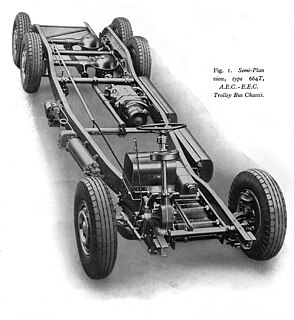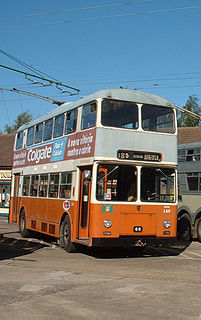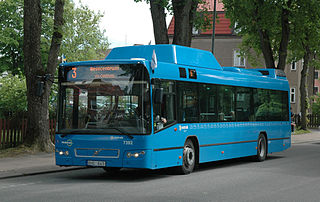 W
WA trolleybus is an electric bus that draws power from dual overhead wires using spring-loaded trolley poles. Two wires, and two trolley poles, are required to complete the electrical circuit. This differs from a tram or streetcar, which normally uses the track as the return path, needing only one wire and one pole. They are also distinct from other kinds of electric buses, which usually rely on batteries. Power is most commonly supplied as 600-volt direct current, but there are exceptions.
 W
WACSM-321 is a Belarusian large capacity low-floor trolleybus for intercity passenger transportation, mass-produced since 2003. It belongs to the third generation of trolleybuses developed by the Belkommunmash plant in Minsk.
 W
WThe AEC 661T was a two-axle double deck trolleybus chassis manufactured by AEC between 1931 and 1942. Based on the AEC Regent bus chassis, 330 were built for United Kingdom operators.
 W
WThe AEC 664T was a 18 ft. 7 5/16 in. wheelbase three-axle double deck trolleybus chassis manufactured by AEC between 1933 and 1942 and designated for installation of up to 74 passengers' rear- or central-entrance 30 ft. (length) x 7 ft. 6 in. (width) body. Based on the AEC Renown bus chassis, 796 were built for British operators including 660 for the London Passenger Transport Board for whom it was primarily developed.
 W
WThe AEC 761T was a two-axle double deck trolleybus chassis manufactured by AEC. Based on the AEC Q-type bus chassis, only five were built; a demonstrator that was later purchased by Bradford, one in Southend-on-Sea and three exported to Sydney, Australia.
 W
WThe trolleybuses of Roma Condesa are permanently parked trolleybuses in the Roma and Condesa neighborhoods of Mexico City that were used for art and other projects. Most were Japanese buses that were donated to Servicio de Transportes Eléctricos by the Kansai Electric Power Company in Japan in 1994, for possible operation, which never came to fruition, and in 2000 they were repurposed by Cuauhtémoc borough in a programme to create educational centers. However, the Trolebuses Educativos programme lasted only a few months. Some of the trolleybuses remained in use as simple reading rooms, but others sat abandoned until 2005, when the “Galería Trolebús” was begun to promote non-traditional art projects. The gallery ceased operations in 2009 due to financial problems, but the buses continued to be used for art projects until about 2014. Two other trolleybuses involved were not Japanese vehicles.
 W
WThe Astra Citelis is an urban solo trolleybus with a low floor, bodywork by Astra Bus Arad, Romania, on an Irisbus Citelis under frame, and outfitted with equipment provided by ICPE SAERP Bucharest. Trolleybus electric thrusters are the latest generation with low power consumption and regenerative electric brakes. Digital control of all systems of electric buses allow easy maintenance and repair of the vehicle.
 W
WThe Electromote was the world's first vehicle run like a trolleybus, which was first presented to the public on April 29, 1882, by its inventor Dr. Ernst Werner von Siemens in Halensee, a suburb of Berlin, Germany.
 W
WThe Electron T19 is a Ukrainian large capacity low-entry trolleybus for intercity passenger transportation, mass-produced since 2014.
 W
WThe Ikarus 415T is a type of trolleybus produced by the Ikarus bus manufacturer in Hungary in 1992 and between 1997 and 2002.
 W
WThe Irisbus Citelis is a low-floor city bus produced by Irisbus from 2005 to 2013 when it was replaced in production by Iveco Urbanway.
 W
WLancia 140 is an Italian trolleybus produced from 1967 to 1968. The vehicles are double decker. Until 1995 trolleybuses of this model were used in Porto, Portugal. This trolleybus had two doors. The electrical equipment was from CGE, and the body, with 58 seats, from Dalfa. 50 units were built Porto.
 W
WThe MAZ-203 is a fully low-floor single-decker bus. It is a representative of second generation of MAZ city buses, being a successor of MAZ-103. It has been built since 2006, there are over 100 models built already. MAZ 203 can be found in Poland, Ukraine, Russia and Romania. In Serbia, MAZ has been working in cooperation with local-based company BIK for the manufacture of BIK-203, a bus manufactured on the basis of the platform of MAZ-203.
 W
WThe Mercedes-Benz O305 was a single deck, double deck and articulated bus manufactured by Mercedes-Benz in Mannheim, West Germany from 1969 until 1987. It was built as either a complete bus or a bus chassis and was the Mercedes-Benz adaptation of the unified German VöV-Standard-Bus design, that was produced by many different bus manufacturers including Büssing, Magirus-Deutz, MAN, Ikarus, Gräf/Steyr, Heuliez, Renault, and Pegaso. The O305 was designed for use as a single-decker bus, however it was later redesigned to accommodate double-decker bodies.
 W
WThe Renault PR100 was a French full-size step-entrance single-decker bus chassis built and marketed originally by Berliet from 1971, and sold as a Renault following the merging of Berliet into Renault Véhicules Industriels.
 W
WRocar DAC was a series of buses and trolleybuses produced by the Autobuzul company of Bucharest, Romania, between 1979 and 2000. They were available in both standard 12-meter models and articulated, 17-meter models.
 W
WRocar De Simon 412E was a model of trolleybus that was manufactured by Rocar in Romania, in 1997 and 2002. A total of only 19 were produced, 18 equipped with DC motors and one with an AC motor. Two were delivered to the Bucharest trolleybus system, #7454 and #7459, another two were delivered to Cluj and the remaining 15 were delivered to Constanta. Models sent to Constanta are equipped with resistor controller instead of electronic chopper.
 W
WThe Škoda 14Tr is a Czech trolleybus that was produced from 1981 to 1998. Prototypes were built in 1972 and 1974.
 W
WŠkoda 15Tr is an articulated trolleybus produced by Škoda Transportation from 1988 to 2004, since 1995 in modernized version 15TrM. It is longer version of Škoda 14Tr.
 W
WŠkoda 24Tr Irisbus is a low-entry trolleybus model built from 2003 until 2014 by Czech trolleybus manufacturer Škoda Electric, supplying electrical equipment, in cooperation with Irisbus, supplying body.
 W
WŠkoda 26Tr Solaris is a low-entry trolleybus model built from 2009 by Czech trolleybus manufacturer Škoda Electric, supplying electrical equipment, in cooperation with Solaris, supplying body.
 W
WŠkoda 27Tr Solaris is a low-entry trolleybus model built from 2010 by Czech trolleybus manufacturer Škoda Electric, supplying electrical equipment, in cooperation with Solaris, supplying body.
 W
WThe Škoda 30Tr SOR is a full-sized low-entry trolleybus produced in cooperation of Škoda Electric and SOR, which supplies the body based on the bus SOR NB 12.
 W
WŠkoda 31Tr SOR is a low-floor articulated trolleybus produced in cooperation of Škoda Transportation and SOR, which supplies the body based on the bus SOR NB 18.
 W
WThe Škoda 32Tr SOR is a full-sized low-entry trolleybus produced in cooperation of Škoda Electric and SOR, which supplies the body based on the bus SOR NS 12.
 W
WSolaris Trollino is a series of low-floor trolleybuses designed for public transport, produced since 1999 by the Polish company Solaris Bus & Coach.
 W
WSOR NB12 is a fully low-floor single-decker bus produced by the Czech bus manufacturer SOR from the Czech Republic since 2008. In many towns they currently replace Karosa B 731, Karosa B 732 and Karosa B 931.
 W
WThe Volvo 7000, later Volvo 7700, was an integrally-constructed fully low-floor single-decker rigid bus and single-decker articulated bus built by Volvo between 1999 and 2012. It was generally available as 12-metre and 18-metre on both diesel and CNG, and from 2010 as a 12-metre hybrid electric. A trolleybus version has also been built.
 W
WThe Volvo B58 was a mid-engined single-decker bus, double-decker bus, single-decker articulated bus and single-decker coach chassis manufactured by Volvo in Sweden from 1966 until early 1982. It was succeeded by the B10M.
 W
WThe ZiU-5 is a Soviet trolleybus model that was built by the Uritsky factory. The ZiU acronym stands for Zavod imeni Uritskogo, which translates as Plant named after Uritskiy. This model of city trolleybus was in mass production from 1959 to 1972. The total number of ZiU-5s produced exceeded 14,500 vehicles. This allowed the ZiU-5 to become dominant model of trolleybus in Soviet towns and cities of that time. The last vehicles were withdrawn from active service in the mid-1980s. The small number of surviving vehicles are kept now for museum purposes.
 W
WZiU-9, or ZIU-9 is a Soviet trolleybus vehicle. Other names and indexes for the same vehicle include ZiU-682 and HTI-682. The ZiU acronym stands for Zavod imeni Uritskogo, which is a plant named after Moisei Uritsky, the Russian revolutionary. Before 1996 this acronym was also a trademark of the vehicle manufacturer. It has been changed to Trolza. The ZiU-9 was put in mass production in 1971 and it was still assembled along with other more advanced trolleybus vehicles in the Trolza factory until 2014. The total number of produced ZiU-9s exceeds 42,000 vehicles. In addition, many copies of ZiU-9 were made in other factories of the former Soviet bloc. This model is the most numerous trolleybus vehicle in the world.
 W
WZiU-10 or ZIU-10, also referred to as ZIU-683, is a model of trolleybus, built in Russia. It was manufactured from 1986 until 2008 by the Uritsky Factory, in Engels, which later became Trolza. It is an articulated, three-axle variant of the ZiU-9/ZiU-682.